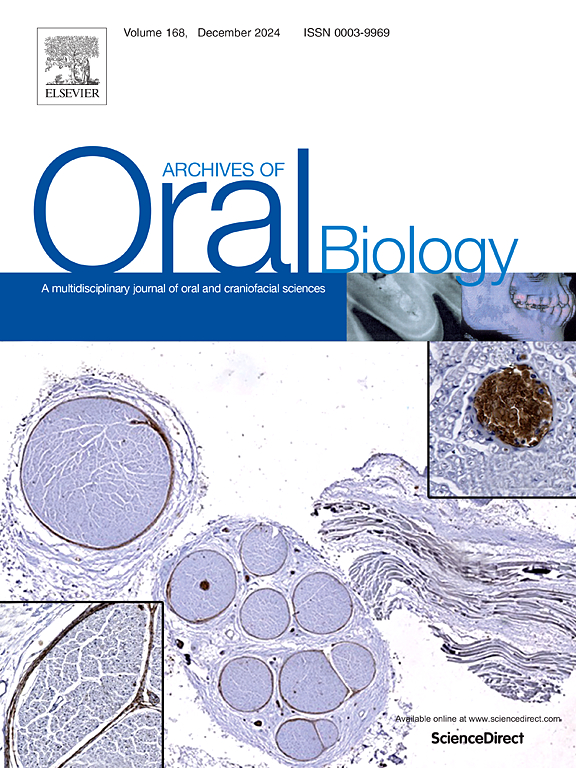Anti-inflammatory, antioxidant, and antimicrobial evaluation of morin
IF 2.1
4区 医学
Q2 DENTISTRY, ORAL SURGERY & MEDICINE
引用次数: 0
Abstract
Objectives
This study aimed to evaluate the anti-inflammatory and antioxidant activity of morin in an epithelial cell culture inflammatory model, as well as its antimicrobial activity against periodontal pathogens. Effects of morin alone or slow-release from a polymer-based formulation were compared.
Methods
An oral epithelial cell line (H400) was pre-conditioned with 0.125 mg/mL morin (free morin or morin in the formulation) for 8 h. The cells were challenged with heat-killed Fusobacterium nucleatum and Porphyromonas gingivalis (MOI 100:1) for 24 h. The production of GM-CSF was measured by enzyme-linked immunosorbent assay (ELISA) and the gene expression levels of IL-8, GM-CSF, IL1B, NF-kB and NLRP3 were evaluated by RT – PCR. Neutrophils were pre-conditioned with 0.01 mg/mL morin and stimulated immediately with heat-killed F. nucleatum or P. gingivalis (MOI 100:1) for 2.5 h and then total reactive-oxygen-species (ROS) levels were determined using enhanced chemiluminescence. F. nucleatum and P. gingivalis as well as a multi-species biofilm (Streptococcus oralis, F. nucleatum and P. gingivalis) were exposed to 1 mg/mL morin for 24 h, planktonic culture and for 7 days, multi-species biofilm. After exposure, the microbial viability (CFU/mL) and biofilm biomass (crystal violet assay) were determined. Live/dead staining and confocal laser scanning microscopy were also performed. Data were submitted to one way ANOVA followed by Tukey's post-hoc test (α=0.05).
Results
Morin and the polymer-based formulation containing morin significantly attenuated secretion of GM-CSF, significantly reduced ROS generation and the gene expression levels of the cytokines tested (p < 0.05). Microbial viability and the biofilm biomass significantly reduced (p < 0.05) after treatment with morin and the polymer-based formulation containing morin.
Conclusions
Morin showed an anti-inflammatory and antioxidant effect as well as antimicrobial properties against periodontal pathogens. In addition, polymer-based formulation enhanced these effects.
桑里素的抗炎、抗氧化和抗菌评价
目的研究桑皮苷在上皮细胞培养炎症模型中的抗炎、抗氧化活性及其对牙周病原菌的抗菌作用。比较了莫里素单独或缓释的聚合物基制剂的效果。方法用0.125 mg/mL桑辣素(游离桑辣素或制剂中桑辣素)预处理口腔上皮细胞株H400,预处理时间为8 h。用热杀灭的核梭杆菌和牙龈卟啉单胞菌(MOI 100:1)攻毒细胞24 h。采用酶联免疫吸附法(ELISA)检测GM-CSF的产量,RT - PCR检测IL-8、GM-CSF、il - 1b、NF-kB和NLRP3的基因表达水平。用0.01 mg/mL morin对中性粒细胞进行预处理,然后立即用热杀死的F. nucleatum或P. gingivalis (MOI 100:1)刺激2.5 h,然后用增强化学发光法测定总活性氧(ROS)水平。将1 mg/mL morin对有核梭菌和牙龈卟啉单胞菌以及多种生物膜(口腔链球菌、有核梭菌和牙龈卟啉单胞菌)进行浮游培养24 h,多种生物膜培养7 d。暴露后测定微生物活力(CFU/mL)和生物膜生物量(结晶紫法)。活/死染色和共聚焦激光扫描显微镜检查。数据进行单因素方差分析,然后进行Tukey事后检验(α=0.05)。结果桑皮素及桑皮素聚合物基制剂均能显著降低GM-CSF的分泌,显著降低ROS的产生及细胞因子基因表达水平(p <; 0.05)。桑皮素和桑皮素聚合物基制剂处理后,微生物活力和生物膜生物量显著降低(p <; 0.05)。结论苦参素对牙周病原菌具有抗炎、抗氧化和抗菌作用。此外,聚合物基配方增强了这些效果。
本文章由计算机程序翻译,如有差异,请以英文原文为准。
求助全文
约1分钟内获得全文
求助全文
来源期刊

Archives of oral biology
医学-牙科与口腔外科
CiteScore
5.10
自引率
3.30%
发文量
177
审稿时长
26 days
期刊介绍:
Archives of Oral Biology is an international journal which aims to publish papers of the highest scientific quality in the oral and craniofacial sciences. The journal is particularly interested in research which advances knowledge in the mechanisms of craniofacial development and disease, including:
Cell and molecular biology
Molecular genetics
Immunology
Pathogenesis
Cellular microbiology
Embryology
Syndromology
Forensic dentistry
 求助内容:
求助内容: 应助结果提醒方式:
应助结果提醒方式:


